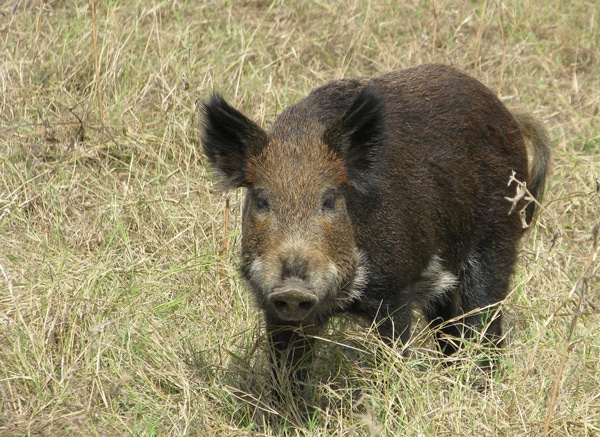
Feral swine invade New Mexico farm and rangeland, threaten agriculture
Wild hogs invading New Mexico rangelandFarmers and ranchers across Eastern New Mexico have been complaining that feral swine have been ravaging range and farmland, destroying milo and sorghum crops and rooting up wheat fields.Feral swine do $800 million in damage annually across the United States.

Feral swine problems are moving west from Texas into Eastern New Mexico causing an environmental and economic disaster for the state’s agriculture industry and threatening a delicate wildlife ecosystem that local, state and federal authorities are struggling to contain.
“We don’t have the large populations or density of feral swine in New Mexico as they do in Texas or Oklahoma, but we have gone from two counties suffering serious pressure from wild pigs to seventeen in an alarming short period of time. We’re new to this ballgame, but already we’re at a point where we would like to see the problem eradicated,” says Alan May, state director for New Mexico’s USDA wildlife services program.
Farmers and ranchers across Eastern New Mexico have been complaining that feral swine have been ravaging range and farmland, destroying milo and sorghum crops and rooting up wheat fields. In addition, wild hogs have been known to prey on lambs and kid goats.
These feral animals also threaten the wildlife of New Mexico as they compete for food and water and are known to carry more than 20 diseases that have decimated livestock herds in the past.
“They will prey on acorns, pinion nut, cactus pear apple, and mesquite beans that serve as natural resources to sustain native wildlife, and they are known to carry the pseudorabies virus, which can be deadly to cattle, horses, pets, and wildlife,” May adds.
Feral swine can also carry a strain of swine brucellosis, a disease that is not fatal to livestock but can cause an infected herd to test false positive for bovine brucellosis, requiring quarantine.
Environmental and wildlife specialists say they initially believed the threat from feral swine would be minimized in New Mexico largely because wild pigs follow rivers and streams in their natural movement across the landscape. Large areas in Eastern New Mexico, often called the Sand Hills region, have few flowing waterways. But May says the feral animals have rooted out windmills and stock ponds and have adapted well to the semi-arid environment.
"The problem has been growing so fast that the state legislature outlawed commercial feral hog hunting, which means that individuals cannot charge a fee to hunt feral hogs in NM. The same law also makes it illegal to move feral hogs around the state. The purpose of this legislation was to limit movement of these very destructive invasive animals and to take away financial gain and reduce the possibility of establishing new feral hog populations in areas that do not currently have feral hogs,” May Said.
Hit the hardest so far is Quay County where alfalfa hay, alfalfa seed, grain sorghum, cotton, and wheat are the leading crops produced. One county producer, Ted Rush, says he has trapped and killed over 300 wild pigs on his property and he continues to have problems.
“There is an eradication plan on the books, but not a budget to support it,” May says. “But we are doing what we can to trim population numbers.”
He says one of the more successful methods is known as the Judas Hog Operation. Large corral traps are placed in a field after an adult sow is captured, sterilized and equipped with a radio transmission device. Large sounders of 20 to 40 pigs get trapped and subsequently eradicated, but the sow is turned loose again and eventually becomes part of another sounder.
“In this way we can not only keep up with movement, but also we have a chance to trap a large number of animals at the same time,” May said.
But May says it is going to take a cooperative effort of government, landowners and sportsman to significantly reduce wild hog numbers in New Mexico, and so far that cooperative effort is proving successful.
“But we’re working against an animal that reproduces and propagates quickly so the battle is uphill,” May says.
As one rancher put it, “There are only two kinds of land owners in New Mexico - those who have feral pigs - and those who will.”
Quick facts
• Feral swine do $800 million in damage annually across the United States.
• Wild hogs begin breeding as young as six months and produce two litters of six to nine offspring annually.
• A hog population can double in four months.
• The average weight of a feral hog is 120 pounds, though they can grow to more than 400 pounds.
• They have razor sharp tusks that can grow to 5 inches.
• Feral hogs prefer to run from humans, but have been known to attack under duress.
About the Author(s)
You May Also Like





